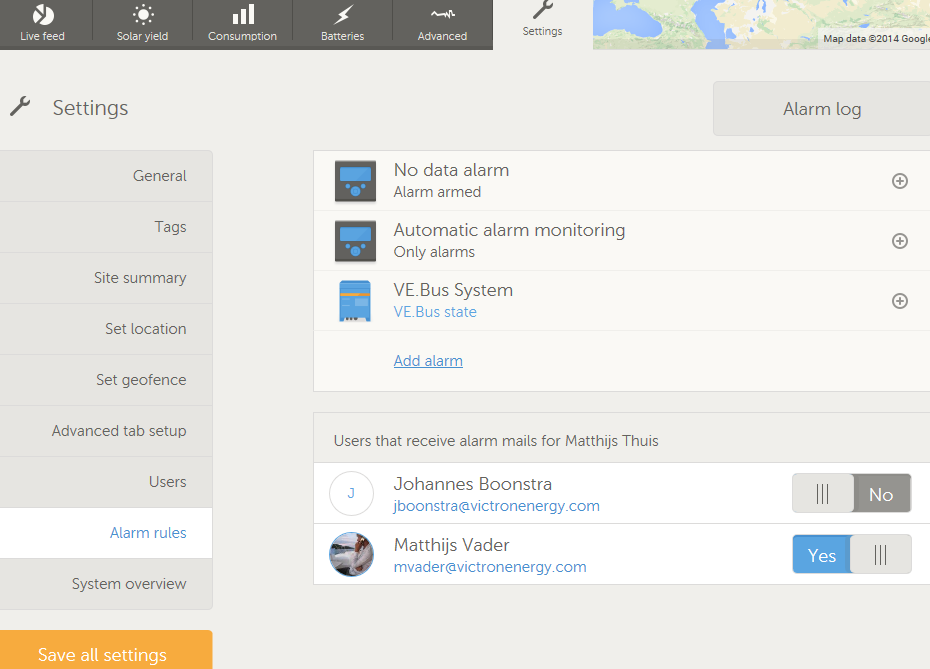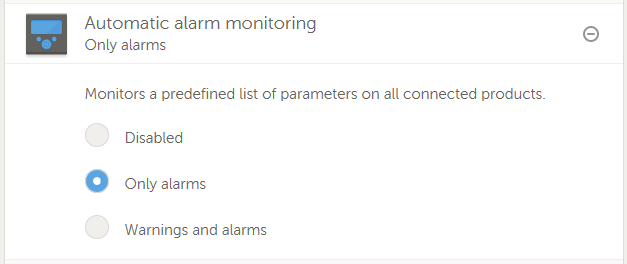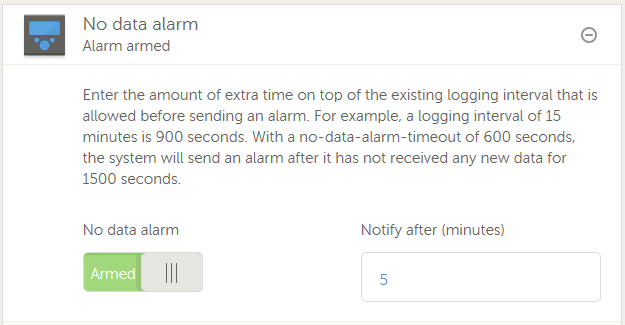This is an old revision of the document!
Table of Contents
VRM Portal alarms and monitoring
The VRM Portal constantly monitors and watches over your system and can also inform you by email if something is amiss. There are four categories of monitoring:
- The no data alarm: monitors the connection between the Portal and the Victron installation
- Automatic alarm monitoring: monitors a predefined list of parameters on all connected products
- Geofence: monitors location (requires a Color Control GX with a USB-GPS)
- User configurable alarms

1. No data alarm
2. Automatic alarm monitoring
Monitors a predefined list of parameters on all connected products. With this feature, it is no longer necessary to manually configure alarm rules for all the different parameters. An email will be sent if any of the parameters listed below enters an Alarm state, and optionally for Warnings too. A recovery email will be sent if the parameter returns to its normal value.
You can set the monitor to send an email alert for alarms only, for warnings and alarms, or disable it entirely. The default for new sites is Only alarms:

2.1 Parameters being watched by the Automatic alarm monitor
2.1.1 VE.Bus products (Multi, Inverter and Quattro)
- VE.Bus state
- VE.Bus Error
- Temperature alarm
- Low battery alarm
- Overload alarm
2.1.2 BMV and Lynx Shunt VE.Can
- High voltage alarm
- Low voltage alarm
- High starter-voltage alarm
- Low state-of-charge alarm
- Low battery temperature alarm (BMV-702 only)
- High battery temperature alarm (BMV-702 only)
- Mid-voltage alarm (BMV-702 only)
- Low fused-voltage alarm (Lynx Shunt only)
- High fused-voltage alarm (Lynx Shunt only)
- Fuse blown alarm (Lynx Shunt only)
- High internal-temperature alarm (Lynx Shunt only)
- Low starter-voltage alarm (Lynx Shunt only)
2.1.3 Solar charger
- Charger fault
- Charge state
- Equalization pending
- Alarm condition
- Low voltage alarm
- High voltage alarm
- Error code
2.1.4 Skylla-i charger
- Charger fault
- Charge state
- Error
- Low voltage alarm
- High voltage alarm
2.1.5 Lynx Ion BMS
- Error code
- Error
3. User configurable alarms
Advanced rules, including hysteresis can be configured for all parameters available in the VRM database.
3.1 How to properly configure high, low and their hysteresis
To understand what the hysteresis is, consider the following example: you want an alarm as soon as the battery voltage drops below 10 volt. And only when it rises again above 11.5 volts, you want the alarm to clear. These 11.5 V is the hysteresis.
A properly configured alarm rule meets the following criteria:
- The low hysteresis should be equal to or higher that the low alarm threshold
- The high hysteresis should be equal to or lower than the high alarm threshold
- The low hysteresis should be lower than the high alarm threshold (otherwise a high alarm will be triggered as soon as the low alarm is cleared)
- The high hysteresis should be higher than the low alarm threshold
Note November 2014: after rereading the exact meaning of hysteresis, I see that this is the concept. And not the right word for the value at which to clear an alarm. We'll rename these items on the and then also this text shortly: Low hysteresis → Clear low alarm above High hysteresis → Clear high alarm below
3.2 Receiving and alarm on mains failure
This is an alarm typically wanted in a backup system.
To set it up:
- Start adding an alarm
- Select the Multi (or Quattro) as the device on which you want to monitor a a parameter.
- Select the VE.Bus State as the parameter.
- Set the Inverter state as 'Armed'. You might want to add Off and Error there as well.
- Set the notification time to 300 seconds, i.e. 5 minutes.
4. Geofence
Typically used for rental vehicles and boats. The example below shows a Geofence that will give an alert when the boat leaves the lake. An alarm will also be generated when the location data is no longer being received, for example when the GPS receiver is unplugged. Use this in combination with the No data alarm for full coverage.

5. Email rate limiter
Under certain conditions, some installations can hover near a warning or alarm condition. This can yield a flow of redundant e-mail messages, leading to user alarm fatigue and spam false positives, not to mention an overflowing inbox.
In case the system detects that this is going on, it will send one last email out. Which contains a warning that due to rate limiting it will stop sending out new emails.
In case the flood of alarms ceases, the system will automatically resume sending out emails.
Also its possible to de-active the rate limiter on the VRM Portal: go to the site, then Settings and Alarm rules. In case the Rate limiter is active, you'll see this:

~~DISQUS~~
 Add this page to your book
Add this page to your book  Remove this page from your book
Remove this page from your book  Manage book (
Manage book ( Help
Help 